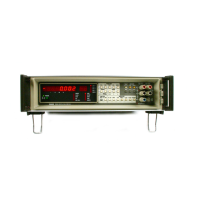3.
The
error buffer is
cleared (set to
00)
when
either of the
following
actions occurs:
a.
TheGI command
is sent. The
error is returned in
the status response,
and the buffer
is reset to 00. If
the error
still exists, a new
reading must be
triggered to reload the
error buffer (and
return the error
message).
If another G1
command is sent
before a new
reading is
triggered, no error
(00)
is
identified in the
response.
b.
A valid
reading is triggered.
The reading is returned
and the
buffer is reset to 00.
The
multimeter employs
both
momentary and
latching errors. A
momentary error in the
buffer can be
cleared
by
sending the G1
command or by
triggering a
valid reading. If the
momentary
error does not
reoccur, further
multimeter
operation
is not impeded.
A
latching error, if not corrected,
does impede
further
multirneteroperation by
generating
another
error (and
returning the
error message) each time a
reading is
triggered.
Clearing the error buffer
by
sending G1 does
not
affect this
impediment.
Latching errors include
12, 13,
14, 15, 19,
and
24.
A
momentary
error
condition is
illustrated in the following
example. Assume that IV dc
is applied to a
multimeter
configured
for dc
volts. The
following sequence of
commands is sent: VR0? KG1?
R1? The first
command (VR0?)
triggers an
overrange, causing the
error message to be
returned. The second
command (KG1
?)
attempts
to store this
overrange as
an offset,
loads momentary
error 11 into the error buffer, and
returns
11
(the
most recent error to be
generated)
in the status
response. The
third command (R1?)
triggers and returns a valid
reading and resets the
error
buffer to
00.
A
latching error
condition is
encountered in the
following example. Assume
that the
multimeter
is
configured for dc
volts (V), but
not dc
current
measurement (I), and IV dc is
applied to the inputs. The
following
sequence of
commands
is
sent: IR1? G1? ? V?
The first command (IR1?)
triggers an invalid
reading, loads the
error buffer with
latching error
19,
and causes
the error message
to
be
returned. The
second command (G1
?)
returns 19 as the
first
two
characters
of the status
response and
resets the error buffer to 00.
The third command
(?)
triggers
another invalid
reading,
loads the
error buffer with 19 again,
and returns the
error message. The
fourth command (V?)
is valid.
Therefore, the
actual reading is
returned, and the error
buffer is reset to
00.
NOTE
Latching
errors are
enabled at all times
(Calibration mode on
or off) when remote
operation is in use.
However,
latching
errors can be disabled
locally (with
Calibration mode on). This
procedure is intended
for use
during
troubleshooting only. Do not
attempt to disable
latching errors at any
other time.
The
following
additional error
conditions can
occupy
the
error buffer for either the
8505A or the
8506A:
1 .
23 : The
Calibration
Memory is faulty or not
installed.
2.
24 :
Illegal module
configuration.
This
error occurs at
power-up or reset. It may
mean that a Calibration
Memory module is
installed. The
8505A and 8506A do
not use a
separate module for calibration
memory entries
(calibration memory is a
standard
part of the Controller
module). If a Calibration
Memory module is
installed, it must be
removed.
Also,
error 24 may
mean that the wrong ac
converter configuration is
installed. The 8505A uses
either the
-01
Option
or
the
-09A Option (not
both). The 8506A uses
only the
Thermal True-RMS Converter.
If an
illegal
ac
converter is installed,
it must be removed, if the
illegal configuration is
not corrected,
the error
buffer is
cleared (G1
sent), and
a
valid function is
subsequently selected, the
illegal module
configuration
does
not interrupt
further multimeter
operation. However, if both ac
converters
(-01 and -09A)
are
installed in the
8505A, the ac volts
command (VA or C) causes
selection of the
-09A converter only.
3.
25 : The
Calibration
Memory check sum is
wrong.
This
error
condition may occur
when applying power, when
storing into
Calibration Memory,
or when
recalling a
Calibration
Memory entry, it may be caused by
an inadvertent
cycling of
power when the
multimeter is in the
Calibration mode.
Ensure that Calibration mode
is off, then try
re-initializing power to
the
multimeter.
If error 25 remains,
it may
be
necessary to
first clear, and then
re-enter, all
correction
factors, zero values,
and the
calibration date (or instrument
identification
number). If error 25
recurs
during the
clearing procedure or
during any subsequent
programming attempt, the
Calibration
Memory
may be
faulty.
2A-3I1

